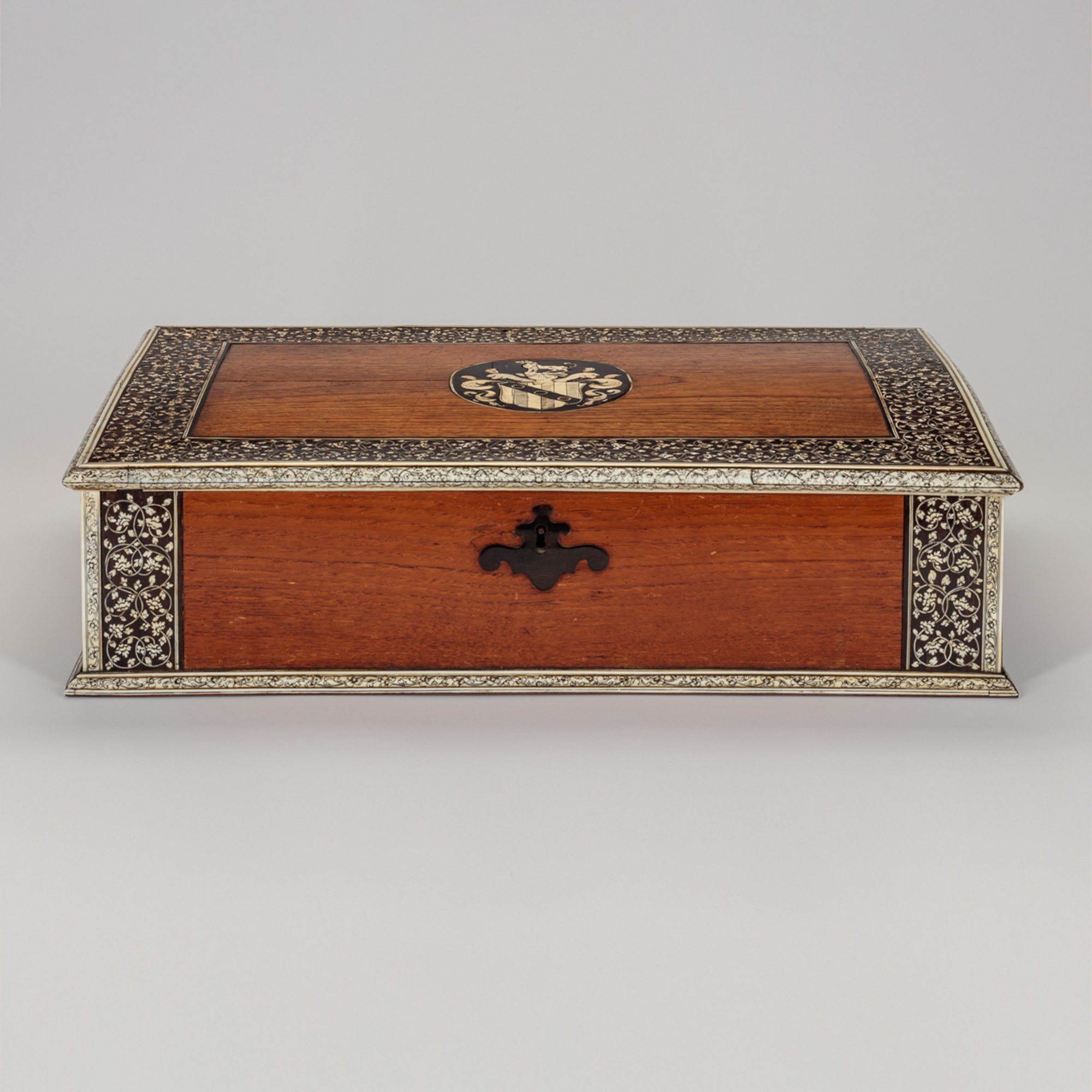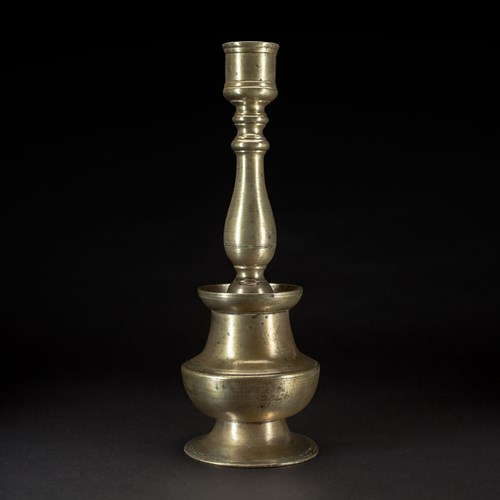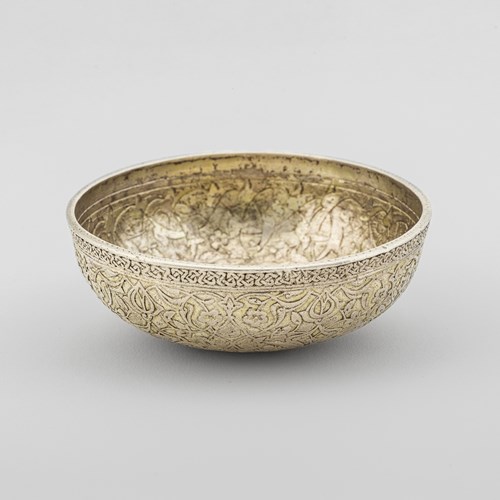Marketplace
Anglo-Indian Writing Box
Anglo-Indian Writing Box
Period First half of 18th century
Origin Vizagapatnam, India
Medium Teak, ebony, and ivory
Dimension 58 x 15 x 40 cm (22⁷/₈ x 5⁷/₈ x 15³/₄ inches)
This large, rectangular box made of teak and ebony is superbly decorated on all sides with borders of fine ivory inlaid flowers and small leaves on scrolling vines. The edges are made of ivory, exquisitely carved with undulating vines with flowers and leaves. In the centre of the lid is the coat of arms made of ivory on a black background – the coat of arms belongs to the Saunderson family. This suggests the box was probably custom-made for this family. The lid opens upwards to reveal a large storage space, with slotted compartments and two small drawers. There are carrying handles to each side and an ebony escutcheon.
The British began their trading activities at Vizagapatnam, a natural harbour in the Coromandel coast in east India, since the 17th century. Example of popular blending of western forms with local craft techniques utilised the available ivory and exotic woods. The region was known for its fine Anglo-Indian furniture with intricate ivory inlay work – the speciality of the local artisans, who adapted the technique to adorn European style furniture including boxes of different shapes and sizes.
There are several boxes from public institutions which can be compared to our example. The Rijksmuseum, Amsterdam holds an ivory inlaid ebony box dated to c.1720-30 (BK-2012-1) that contains a design of undulating scrolls with flowers and leaves, but on a larger scale than our example. Whereas a casket from the Victoria and Albert Museum (402-1854) offers a visually similar ivory inlaid design as our item, with undulating scrolls with flowers and leaves on a much smaller scale than those on the Amsterdam box. It has been suggested that the decorative scheme on such boxes were inspired by locally produced textiles manufactured in the first quarter of the 18th century (Jaffar, 2001). Palampores (bed covers) from the Coromandel Coast had densely floral designs amidst scrolling vines and leaves; the main motif was in the centre within a rectangular border. The same format seems to have been transposed to the decorative design on the boxes.
Our box is an example of the fine local craftsmanship on the Coromandel Coast, made to European taste with distinct characteristics, and can be regarded as examples par excellence of the export trade.
Comparative material:
The Rijksmuseum, Amsterdam (BK-2012-1);
Victoria and Albert Museum, London (402-1854);
Jaffar, 2001, p.179, fig.79 (Document box of ebony and rosewood, inlaid with ivory, Vizagapatam, 1710-20);
Jaffar, 2001, p.181, fig.80 (Document box of ebony, inlaid with ivory, with the arms of the Mossel family, 1720-30).
Reference:
Jaffer, Amin, and Karina Corrigan. Furniture from British India and Ceylon: A Catalogue of the Collections in the Victoria and Albert Museum and the Peabody Essex Museum. London: V&A Publications, 2001.
Stock No: A5380
This item contains less than 10% ivory and has been registered with Defra.
The British began their trading activities at Vizagapatnam, a natural harbour in the Coromandel coast in east India, since the 17th century. Example of popular blending of western forms with local craft techniques utilised the available ivory and exotic woods. The region was known for its fine Anglo-Indian furniture with intricate ivory inlay work – the speciality of the local artisans, who adapted the technique to adorn European style furniture including boxes of different shapes and sizes.
There are several boxes from public institutions which can be compared to our example. The Rijksmuseum, Amsterdam holds an ivory inlaid ebony box dated to c.1720-30 (BK-2012-1) that contains a design of undulating scrolls with flowers and leaves, but on a larger scale than our example. Whereas a casket from the Victoria and Albert Museum (402-1854) offers a visually similar ivory inlaid design as our item, with undulating scrolls with flowers and leaves on a much smaller scale than those on the Amsterdam box. It has been suggested that the decorative scheme on such boxes were inspired by locally produced textiles manufactured in the first quarter of the 18th century (Jaffar, 2001). Palampores (bed covers) from the Coromandel Coast had densely floral designs amidst scrolling vines and leaves; the main motif was in the centre within a rectangular border. The same format seems to have been transposed to the decorative design on the boxes.
Our box is an example of the fine local craftsmanship on the Coromandel Coast, made to European taste with distinct characteristics, and can be regarded as examples par excellence of the export trade.
Comparative material:
The Rijksmuseum, Amsterdam (BK-2012-1);
Victoria and Albert Museum, London (402-1854);
Jaffar, 2001, p.179, fig.79 (Document box of ebony and rosewood, inlaid with ivory, Vizagapatam, 1710-20);
Jaffar, 2001, p.181, fig.80 (Document box of ebony, inlaid with ivory, with the arms of the Mossel family, 1720-30).
Reference:
Jaffer, Amin, and Karina Corrigan. Furniture from British India and Ceylon: A Catalogue of the Collections in the Victoria and Albert Museum and the Peabody Essex Museum. London: V&A Publications, 2001.
Stock No: A5380
This item contains less than 10% ivory and has been registered with Defra.
Period: First half of 18th century
Origin: Vizagapatnam, India
Medium: Teak, ebony, and ivory
Dimension: 58 x 15 x 40 cm (22⁷/₈ x 5⁷/₈ x 15³/₄ inches)
More artworks from the Gallery








 Flower (Large)_T638206163546965508.JPG?width=500&height=500&mode=pad&scale=both&qlt=90&format=jpg)
_T638657944608893064.jpg?width=500&height=500&mode=pad&scale=both&qlt=90&format=jpg)